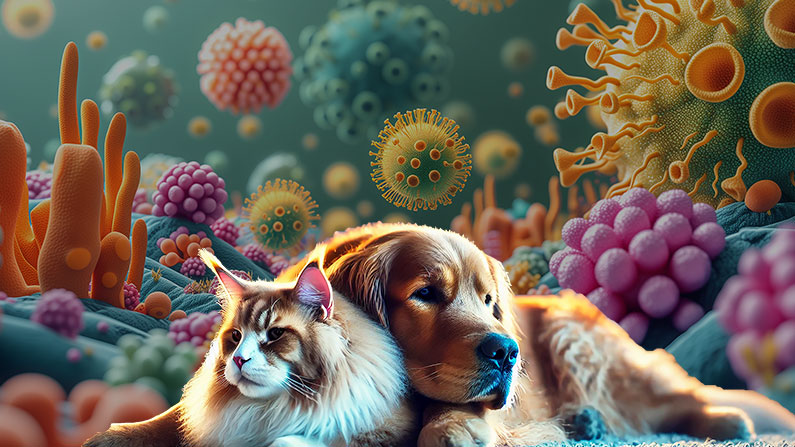Posts in Category: You & Your Pet
Meet Your Microbes

A few months ago, I had the opportunity to represent our clinic at a conference entitled Combating Antimicrobial Resistance with Stewardship, hosted by the Chicago Department of Public Health. It was wonderful to see professionals in all different sorts of medical fields come together to discuss topics that affect us all in how we manage our ever-developing love-hate relationship with these bugs that live all around and inside of us.
The average person has 38 trillion bacterial cells inside of them. These microbes are just as much of us and our pets as our very own cells. Bacteria are vital to our daily lives and the lives of our pets. Our understanding of our relationship with these little guys is constantly evolving. That’s why I feel it’s important to review some of the terminology related to the medications and practices used to manage bacteria.
Microbiome
This is a catchall word that refers to all the single-cell organisms that live in the body. The microbiome includes all bacteria, viruses, fungi, and protozoa that can be found inside and on the body of any animal. There are good bugs and bad bugs. They can affect everything from the smell of our breath to rashes on our skin.
People often think “microbiome” relates just to the digestive system, but it also includes any organ system where these little ones can live, such as the skin, reproductive systems, oral cavity, and respiratory systems. For the most part, these organisms live in harmony with the animal’s body. When there is an imbalance, however, or some of these critters take up space where they don’t belong, the result can mean illness for us and our pets.
Probiotics
A probiotic is a bacterium that has been found to improve gut health. (You may see probiotic products for people for other parts of the body, but in veterinary medicine probiotics almost exclusively relate to the GI system.)
For our dogs and cats especially, gut health is determined by stool quality. Diarrhea in a pet is often a sign that pathologic (bad) bacteria and other microorganisms have overpopulated. In these cases, introducing a good bacteria can help reestablish balanced populations of bacteria and improve stool quality.
Many veterinary studies in recent years have shown that giving a probiotic helps control diarrhea faster than giving an antibiotic. Plus, probiotics may make diarrhea less likely to return in the future.
Antibiotics
These don’t need a lot of explanation, but just so that we’re all on the same page, antibiotics are medications that kill bacteria by targeting cellular function that is specific to bacterial cells and not our cells.
There are different kinds of antibiotics, categorized by what kinds of bacteria they attack, how powerful they are, and how they work (e.g., by killing the bacteria or just keeping them from reproducing).
The discovery of antibiotics is arguably the most important discovery of modern medicine. But it is also important to note that the more we use these drugs the less effective they can get. It’s vital that veterinarians and other medical professionals be judicious with their use.
Antiseptics
These are compounds that try to kill any microbial life. They don’t have to be specific to one type of bacteria or virus. These are most often used topically on the skin or cleaning surfaces. I feel that we often skip over antiseptics and think only of antibiotics, but antiseptics can be a valuable tool in keeping our pets healthy and keeping the bad bacteria under control
Prebiotics
This term is a bit newer to many of us. For a long time, most medical professionals thought you could manage the microbiome either by trying to take away bad bugs (using antibiotics and such) or by adding probiotics. Recently, attention has turned to prebiotics, especially among dog food companies.
Prebiotics are typically non-soluble (meaning we don’t absorb them) foods that the “good” bugs in the microbiome like. It may seem a bit obvious, but it’s a lot easier to put food into dog and cat food than to put probiotics into a food. A probiotic has to be alive to perform its function, but food is food. Prebiotics give the good bacteria the fuel they need to thrive, which is easier to do than delivering living good bacteria.
So, there’s your refresher! I hope it was a lot less painless than all of the microbiology classes I had to take in veterinary school. I still shudder thinking about trying to remember which viruses have cellular membranes or whether or not certain protozoa are found in certain chambers of a cow’s stomach.
Now go have a banana-oat-kefir milk smoothie and give those little buggers a treat!
Alyssa Kritzman, DVM
Feature illustration from AdobeStock images
